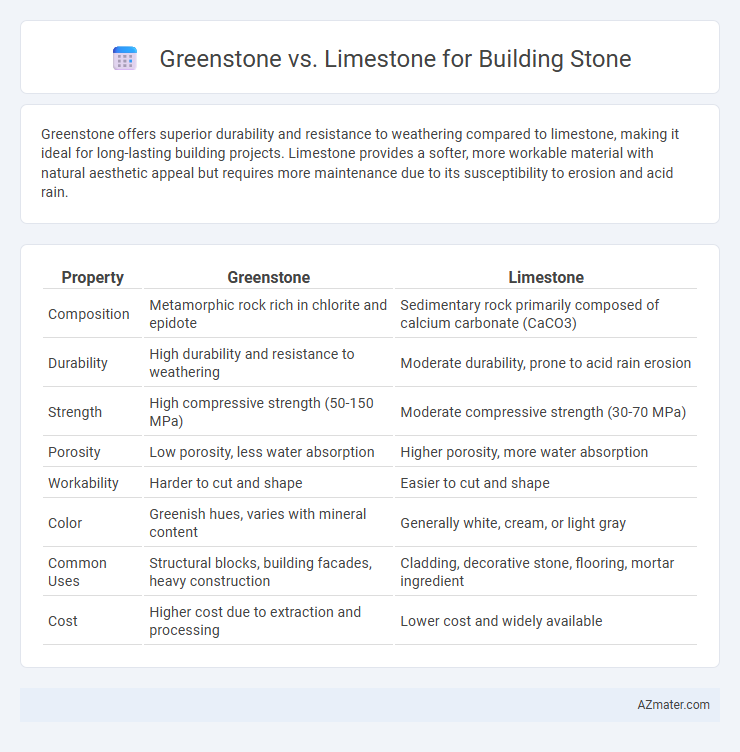Greenstone offers superior durability and resistance to weathering compared to limestone, making it ideal for long-lasting building projects. Limestone provides a softer, more workable material with natural aesthetic appeal but requires more maintenance due to its susceptibility to erosion and acid rain.
Table of Comparison
| Property | Greenstone | Limestone |
|---|---|---|
| Composition | Metamorphic rock rich in chlorite and epidote | Sedimentary rock primarily composed of calcium carbonate (CaCO3) |
| Durability | High durability and resistance to weathering | Moderate durability, prone to acid rain erosion |
| Strength | High compressive strength (50-150 MPa) | Moderate compressive strength (30-70 MPa) |
| Porosity | Low porosity, less water absorption | Higher porosity, more water absorption |
| Workability | Harder to cut and shape | Easier to cut and shape |
| Color | Greenish hues, varies with mineral content | Generally white, cream, or light gray |
| Common Uses | Structural blocks, building facades, heavy construction | Cladding, decorative stone, flooring, mortar ingredient |
| Cost | Higher cost due to extraction and processing | Lower cost and widely available |
Introduction to Greenstone and Limestone
Greenstone is a metamorphosed volcanic rock known for its durability, hardness, and fine-grained texture, commonly used in construction for its strength and resistance to weathering. Limestone is a sedimentary rock primarily composed of calcium carbonate, favored in building applications for its workability, aesthetic appeal, and ability to be polished. Both stones offer distinct structural and visual properties suited to different architectural needs, with greenstone excelling in toughness and limestone prized for its classic appearance.
Geological Formation and Characteristics
Greenstone originates from metamorphosed basaltic rocks primarily found in ancient volcanic island arcs, characterized by dense, fine-grained texture and high durability due to its mafic mineral content. Limestone, formed mainly in marine environments through the accumulation of calcium carbonate from organisms, exhibits a sedimentary structure with varying porosity, often softer and more workable than greenstone. Greenstone's hardness and resistance to weathering make it ideal for structural elements, while limestone is favored for decorative facades and interior finishes due to its ease of carving and fossil content.
Physical Properties Compared
Greenstone exhibits higher density and compressive strength than limestone, making it more suitable for structural applications requiring durability. Limestone typically has lower hardness and is more porous, leading to increased water absorption and potential weathering over time. The abrasion resistance of greenstone surpasses that of limestone, enhancing its longevity in high-traffic or exposed environments.
Aesthetic Differences: Color and Texture
Greenstone exhibits a distinctive green to blue-green hue caused by the presence of chlorite, epidote, and actinolite minerals, offering a unique aesthetic appeal compared to limestone. Limestone typically ranges from white and cream to beige and light gray, featuring a fine-grained, uniform texture that contrasts with the more varied, often phyllitic or schistose texture of greenstone. The smooth, consistent surface of limestone complements classical architectural styles, while greenstone's varied texture and color contribute to a more rugged, natural appearance in building facades.
Durability and Weather Resistance
Greenstone offers superior durability and weather resistance compared to limestone, making it ideal for structures exposed to harsh environmental conditions. Its dense, fine-grained composition resists erosion, freeze-thaw cycles, and chemical weathering more effectively than the porous and softer limestone. Limestone, while easier to carve and aesthetically versatile, is more susceptible to acid rain and surface deterioration over time, limiting its longevity in demanding climates.
Workability and Ease of Shaping
Greenstone offers moderate workability with a fine-grained texture that allows for precise shaping and carving, making it suitable for intricate architectural details. Limestone is highly favored for its softness and uniform grain, enabling easier cutting, shaping, and finishing compared to harder stones like greenstone. The ease of shaping limestone reduces labor and tool wear, making it a preferred choice for both structural and decorative building elements.
Environmental Impact and Sustainability
Greenstone, a metamorphic rock, generally exhibits better environmental sustainability than limestone due to its durability and lower maintenance requirements, reducing long-term resource consumption. Limestone extraction often involves extensive quarrying that contributes to habitat disruption and carbon emissions, whereas greenstone quarrying typically has a smaller ecological footprint. The natural weather resistance of greenstone extends the lifespan of structures, promoting sustainability by minimizing the need for frequent repairs and replacements.
Cost Comparison and Availability
Greenstone generally has a higher cost than limestone due to its durability and limited quarry locations, making it less widely available. Limestone is more abundant and easier to source globally, resulting in lower prices and greater accessibility for construction projects. The cost-effectiveness of limestone makes it a preferred choice in large-scale building applications where budget constraints are significant.
Common Architectural Applications
Greenstone, valued for its durability and fine-grained texture, is commonly used in decorative facades, paving, and interior flooring, providing a sleek, dark-toned aesthetic in modern architecture. Limestone, prized for its workability and warm, beige to gray hues, is extensively applied in load-bearing walls, columns, and sculptural elements, offering classic elegance to historical and contemporary buildings. Both stones are favored in architectural restoration and landscaping, with limestone often chosen for its ability to be intricately carved and greenstone for its high resistance to weathering.
Choosing the Right Stone for Your Project
Greenstone offers exceptional durability and resistance to weathering, making it ideal for structural elements and outdoor applications requiring long-lasting strength. Limestone provides aesthetic versatility with its range of colors and textures, often preferred for decorative facades and interior finishes due to its workability. Selecting the right stone depends on the project's functional needs and design goals, where greenstone suits heavy-duty construction and limestone enhances architectural elegance.

Infographic: Greenstone vs Limestone for Building Stone
 azmater.com
azmater.com